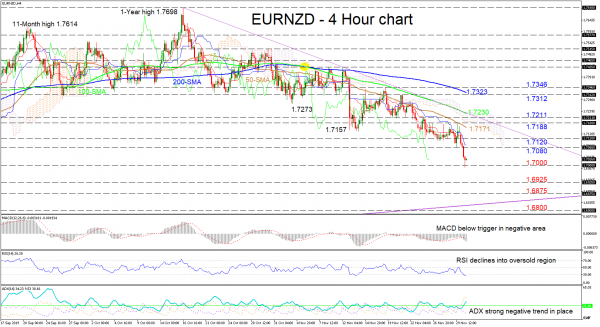EURNZD is currently encountering some upside pressure at the 1.7000 barrier, following the one-and-a-half month decline from the peak of 1.7698. Nevertheless, bearish signals indicate that the downfall may have some ways to go.
The short-term oscillators suggest that negative momentum is strengthening. The MACD, in the negative zone is declining below its red trigger line, while the RSI has slipped into the oversold territory. Moreover, the ADX reflects a strong negative trend in place, as do the downward sloping simple moving averages (SMAs). Additionally, the pair is trading way below the Ichimoku cloud and the restrictive line.
If sellers resurface and continue to control the market, a dive below the 1.7000 mark could plunge the price towards the 1.6925 inside swing high from July 31 ahead of the support of 1.6875. Steering lower, the supportive line drawn from February 2017 may deny the fall to test the 1.6800 trough from August 1.
Otherwise, if buyers pick up and drive the price back up, initial resistance could come from the 1.7080 and 1.7120 levels. Next, the 50-period SMA at 1.7171 could hinder the test of the Ichimoku cloud and resistance region of 1.7188 to 1.7211 ahead of the 100-period SMA at 1.7230. Conquering this, traders’ attention could turn to the area of 1.7312 to 1.7346, which encapsulates the 200-period SMA currently at 1.7323.
In brief, the short-term bias is bearish and a break below 1.7000 would strengthen the negative outlook. Yet, a shift above 1.7346 could return a neutral-to-bullish sentiment.
















